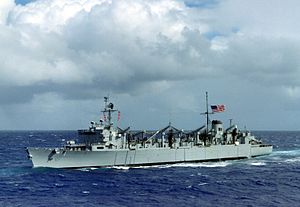
| |
| History | |
|---|---|
| Name | USS Sacramento |
| Namesake | Sacramento, California |
| Ordered | 8 August 1960 |
| Builder | Puget Sound Naval Shipyard, Bremerton, Washington |
| Laid down | 30 June 1961 |
| Launched | 14 September 1963 |
| Commissioned | 14 March 1964 |
| Decommissioned | 1 October 2004 |
| Stricken | 1 October 2004 |
| Homeport | Bremerton, Washington |
| Motto | Ready for Service |
| Nickname(s) | "Golden Bear" |
| Fate | Scrapped at ESCO Marine, Brownsville (USA). Scrapping complete 11 July 2008 |
| General characteristics | |
| Class and type | Sacramento-class fast combat support ship |
| Displacement |
|
| Length | 796 ft (243 m) |
| Beam | 107 ft (33 m) |
| Draft | 38 ft (12 m) |
| Installed power | 100,000 shp (75 MW) |
| Propulsion |
|
| Speed | 30 knots (56 km/h; 35 mph)+ |
| Capacity |
|
| Complement | 34 officers and 602 enlisted |
| Sensors and processing systems |
|
| Electronic warfare & decoys | |
| Armament |
|
| Aircraft carried | 2 × CH-46A/D Sea Knight helicopters |
USS Sacramento (AOE-1) was the third ship in the United States Navy to bear the name, for both the river, and the capital city of California. She was the lead ship of her class of fast combat support ship.
She combined the functions of three logistics ships in one hull; fleet oiler (AO), ammunition ship (AE), and refrigerated stores ship (AFS).
Admiral Arleigh Burke originated the concept of a single supply ship system. He saw the design as an answer to logistics problems he encountered during World War II. The limited speed, range, and payload of early underway replenishment (UnRep) groups prevented resupply due to bad weather and tactical demands of the war. To counter these problems, the Fast Combat Support Ship (AOE) was designed.